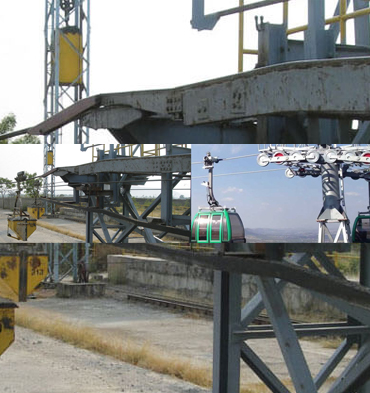Welcome to factory & industry business
Industrial Ropeways
Product Description
ROPEWAYS
Ropeways are very versatile - They come in different types, consist of different elements and can be constructed very quickly.
Ropeways are mature, efficient and comfortable means of transport that are used mainly in the areas of tourism and industrial.
Thanks to their specific characteristics, such as flexibility and cost efficiency, ropeways are also gaining in importance as a means of transport in urban areas.
Cities, ski resorts, passenger as well as material transportation, tourist attractions-ropeways are now much in demand wherever there is need to transport lots of people and material easily, safely and in an environmentally friendly way.
At AARCON ropeways systems are high quality, sustainable, high-tech solutions with ambitious designs. After all, ropeways have long since ceased to be just a means of transportation from the valley to the hills. Each AARCON ropeway is unique.
Why Ropeway – As A Transport Solution?
Most Environmental friendly – No harmful emissions, noise generation
More Energy Efficient
Least Land Requirement
Least deforestation
High service quality – continuous transportation
No disturbance to flora and fauna
Cost Effective
Least Installation Time
Most suitable for difficult terrains
Most reliable.
Benefits of Ropeways
Mass Transit
Gondola, cable car and aerial tramway systems are increasingly being implemented worldwide as People Movers for mass transit and these aerial gondolas are interconnecting with bus, rail and APM’s at intermodal transit centers.
Automation
Equivalent to automatic train controls; aerial tramway and gondola systems are fully automated with redundant, fail-safe electronic monitoring and control systems for optimal safety - safety records exceed those of all surface transit.
Right of Way
Operating in exclusive aerial ROW's, gondolas, tramways and cable cars are separated from roadways, traffic, intersections, sidewalks bikes and pedestrians. In this manner, safety is greater and congestion is minimized versus surface modes of transit.
Headways
No waiting at stations for vehicles to arrive - cabin intervals are normally 15 to 30 seconds; Gondola system's “walk up and board” feature assures there are multiple vehicles in stations ready for boarding at all times
Capacity
Due to the frequent vehicle arrivals / departures, passenger carrying capacities can range from 2,000 to 5,000 people per hour per direction; capacities are regulated for peak and non-peak operation.
Speed
Aerial gondola systems are slower (travelling10 to 18 mph) than most surface transit modes, but average route speed can be greater with the short headways and no speed loss from traffic congestion, traffic lights, weather conditions, etc.
Mobility
Aerial Gondola and Tramway systems are fully ADA compliant with wide cabin doors, and level boarding platforms and vehicle floors; in most cases wheelchairs can board / de-board with no special procedures or stopping the system.
Vehicles
Gondola cabins normally range in size from 10 to 35 passengers and offer seating and standing, and are available with wireless internet, intercom, closed circuit TV, lighting, ventilation, heating, air conditioning and bike racks.
Construction
Minimal right of way footprint and less civil works and infrastructure relocation result in 12 to 18 month construction times and much less disruption along route; neighborhoods are less physically and time impacted.
Sustainability
Innovative electric “green mode” of transit with minimal air and noise pollution compared to other transit modes. On board vehicle power is solar / battery and main electric motive power source can be wind / solar credits.
Cost
Aerial Ropeway capital costs and annual O&M costs are significantly less than most surface rail or fixed guideway people movers. System life cycles are 30 to 50 years, depending on annual operating hours and preventive maintenance.

